NIF & PS People - 2014
September
NIF Target Milestones and Key Partnerships Celebrated
Two important milestones achieved by the NIF&PS and Weapons and Complex Integration (WCI) directorates’ Target Fabrication Team and their key partnerships were celebrated on Sept. 19.
Target Fabrication Manager Alex Hamza kicked off the celebration by announcing the first milestone: This summer, the team built the 10,000th target for the OMEGA Laser Facility at the University of Rochester’s Laboratory for Laser Energetics (LLE).
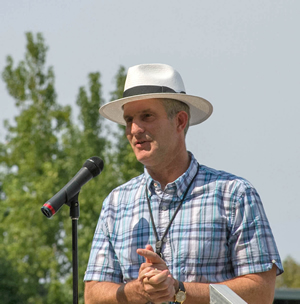 Alex Hamza announces two target milestones. (Credit: Julie Russell)
Alex Hamza announces two target milestones. (Credit: Julie Russell) “When I think about NIF, two things always come to my mind,” said Jeff Wisoff, principal associate director for NIF&PS. “First is the incredible engineering that happens on a large scale and on a small scale. Of course, today we are celebrating the small scale with targets.
“But the other thing is the partnerships,” he said. “The OMEGA facility has been an incredible partner and LLE is incredibly important to us. OMEGA has provided the testing ground for a lot of things we wanted to do on NIF. It’s a very enabling capability, and our success in building targets for that facility is part of that great partnership.”
The second milestone announced by Hamza was the completion of the 500th cryogenic target for NIF. This is an important achievement because these millimeter-sized targets are complicated engineering marvels in tiny packages—so complicated that targets were produced at a rate of one per year when the capability first got off the ground in 2005.
Design and fabrication is so complex because of the precision required for the targets to perform under the extreme conditions experienced during a NIF experiment—temperatures of 180 million degrees Fahrenheit and pressures of 100 billion atmospheres. Components must be machined to within an accuracy of one micron (one-millionth of a meter) and many material structures and features can be no larger than 100 nanometers—just 1/1,000th the width of a human hair.
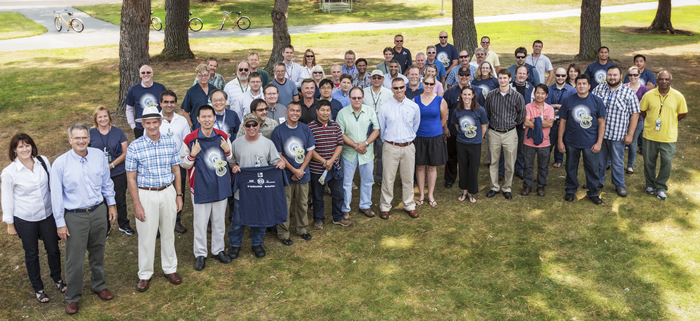 Participants in the NIF target celebration.
Participants in the NIF target celebration. The capsule must have a smoothness tolerance approaching ten nanometers, or 1/10,000th the thickness of a human hair. Finally, the target temperature is held in the range of 18 to 20 kelvins (-427 to -424 degrees Fahrenheit) just before the laser shot so that an incredibly smooth and uniform solid hydrogen fuel layer can be formed.
Many different target designs exist—for Stockpile Stewardship purposes, for high-energy-density science, and for Discovery Science experiments. Today, the Target Fabrication Team has the capability to produce five to six cryogenic targets a week and more than 100 different types of targets each year.
“This is an incredible success story that has been so enabling in moving the science forward,” Wisoff said. “We couldn’t have done this without the incredible partnerships we’ve had with General Atomics and Schafer over the years. That partnership, and the partnerships that extend through our organization, are really what enables us to be successful.”
Des Pilkington, leader of WCI’s AX Division, was on hand to speak to one of those partnerships.
“We really push ourselves hard in WCI to think about what the right experiments are and what we want to do to test our ability to demonstrate that we have a predictive capability,” he said. “In Target Fabrication, the response to some of these pushing needs from WCI has been incredible. I’d like to say thank you for everything that you’ve done, and everything you’ve delivered for us so far. I’m really looking forward to an exciting future with exciting challenges for us and for you.”
Abbas Nikroo, leader of General Atomics’ Target Fabrication Program, echoed those thanks. “It’s been a pleasure working with you guys—top quality people from the S&T (science & technology) Team to the Engineering Team to the people on the floor who do the hard work of (target) assembly,” he said. “I see the transition we’ve made to streamlined production, where we’ve gone from one target a year to five to six targets a week. It’s incredible, and is really built on the great work that everyone has done at all levels.”
 Target designer Rick Heredia works on a new Metrology Rotary Target System for measuring NIF targets. The system will accept integrated warm and cryogenic target mounting bases using a quick-release kinematic mount for inspecting and performing metrology for OGP (Optical Gaging Products)-based metrology. It will automate the rotation of the target about its base axis according to a metrology routine, greatly reducing time and effort by eliminating the need to establish new coordinate systems each time a target is rotated, as is required with the present manual practice.
Target designer Rick Heredia works on a new Metrology Rotary Target System for measuring NIF targets. The system will accept integrated warm and cryogenic target mounting bases using a quick-release kinematic mount for inspecting and performing metrology for OGP (Optical Gaging Products)-based metrology. It will automate the rotation of the target about its base axis according to a metrology routine, greatly reducing time and effort by eliminating the need to establish new coordinate systems each time a target is rotated, as is required with the present manual practice. Susana Reyes Assumes Chair of ANS Fusion Energy Division
LLNL nuclear engineer Susana Reyes has assumed the 2014-15 chairmanship of the American Nuclear Society (ANS) Fusion Energy Division following her election as vice-chair in 2012.
Reyes has more than 12 years of experience in international fusion projects. She joined LLNL in 2001 to pursue her interest in fusion science and worked on the safety analysis of inertial fusion energy power plant designs. Since then, she has worked in a variety of fusion research projects, such as the U.S. ITER Test Blanket Module program for the testing of tritium breeding blanket concepts within the ITER magnetic fusion facility now under construction in Cadarache, France. She also has been strongly involved in neutronics and materials damage simulations at LLNL in support of high-energy accelerators and NIF. From 2006 until early 2010, Reyes took a leave of absence from LLNL to join the ITER Organization in France to support the project through the performance and coordination of safety analyses and associated documentation in preparation for ITER licensing.
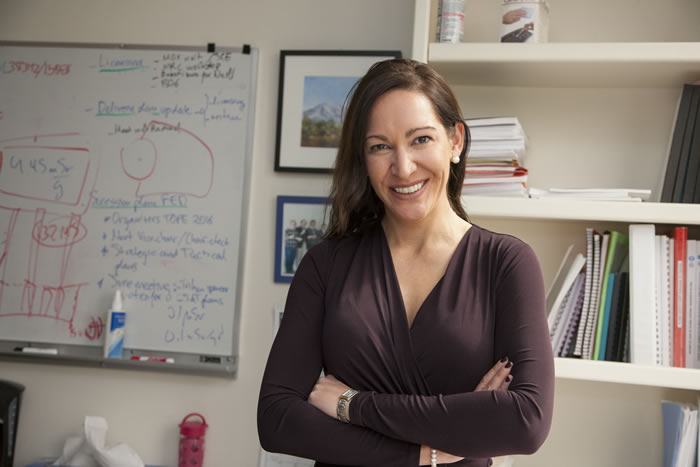 Susana Reyes
Susana Reyes Reyes said her main objective as chair of the ANS Fusion Energy Division is to “promote the development and timely introduction of fusion energy as a sustainable energy source with favorable economic, environmental, and safety attributes, through cooperation with other organizations on common issues of multidisciplinary fusion science and technology.” View a profile and video interview for more about her career and plans.
Among the major activities planned by the Division over the next two years are the bi-annual ANS Topical Meeting on the Technology of Fusion Energy (the next one is in November 2014), and co-sponsoring several other meetings important to fusion science and technology. The Division also supports the ANS journal, Fusion Science and Technology, and the professional recognition of members by means of three awards in the area of fusion. For more information visit the Fusion Energy Division Website.
Reyes earned a Master of Science degree in power engineering from the Polytechnic University of Madrid in 1998 and a Ph.D. in nuclear engineering from the UNED University in Madrid in 2001. In 2012, she received the ANS Mary Jane Oestermann Professional Women’s Achievement Award, which recognized her “leadership in developing detailed hazard and safety analyses for both inertial and magnetic fusion facilities, including NIF and ITER, and future power reactors.” This award is given annually for outstanding personal dedication and technical achievement by a woman in the fields of nuclear science, engineering, research or education.
The American Nuclear Society is a scientific and educational organization working to promote the awareness and understanding of nuclear science and technology. Membership comprises 11,000 engineers, scientists, administrators and educators representing more than 1,600 corporations, educational institutions and government agencies.
NIF Researcher at the Frontiers of Engineering
Rebecca Dylla-Spears, a chemical engineer in NIF’s Target Systems and Optics Technology group, had a chance to collaborate with the nation’s top mid-career engineers from industry, academia and government from Sept. 11 to 13. She was selected to represent LLNL at the National Academy of Engineering’s 20th annual U.S. Frontiers of Engineering symposium. The event in Irvine, California, featured dozens of engineers from ages 30 to 45 who are performing exceptional engineering research and technical work in a variety of disciplines.
 LLNL chemical engineer Rebecca Dylla-Spears inspects a solid deuterium-tritium fuel layer for use in a NIF experiment. Credit: Julie Russell.
LLNL chemical engineer Rebecca Dylla-Spears inspects a solid deuterium-tritium fuel layer for use in a NIF experiment. Credit: Julie Russell. “I feel honored to be selected for this symposium,” Dylla-Spears said. “There are many great engineers at Lawrence Livermore, and I feel humbled to be representing them. I hope to be an ambassador for the Lab and show the quality of research here.”
In addition to networking, conference attendees discussed four main topic areas: next generation robotics, frontiers in materials for batteries, shale gas and oil and technologies for the heart. Whether or not these areas are the main focal points of an attendees’ research, event organizers sought a variety of engineers to share their expertise and offer new ways of solving problems.
Dylla-Spears has been solving complex problems in support of NIF for the past four years. She is working on multiple projects, including growing solid deuterium-tritium (DT) layers for ignition targets and a new technology for polishing glass optics. The latter was one of two NIF & Photon Science projects that recently won R&D 100 awards, which often are referred to as the “Oscars of Invention.”
Her NIF team, led by principal investigator Tayyab Suratwala, developed a new method for optical polishing known as convergent polishing, which enables the finishing of flat and spherical glass optics in a single iteration, with no metrology or process adjustments, regardless of the initial shape of the glass.
This technique has the potential to lower the cost of finished laser optics and has broader application to the optics and chemical-mechanical polishing industries. Dylla-Spears’ contributions included the development of a chemical stabilization method for common optical polishing slurries that reduces particle agglomeration without reducing material removal rate by using a potentially novel mechanism.
Dylla-Spears also leads a team charged with optimizing the process for producing round, smooth and defect-free solid DT layers for NIF targets, which are essential for achieving maximum neutron yield in fusion ignition experiments. Efforts to grow a spherical, single-crystalline layer of deuterium and tritium are complicated by stringent NIF target requirements. Most processes for defect-free crystals start growth from a single seed of known orientation; however, a seed for a NIF DT layer must be generated within the two-millimeter capsule and its presence must be inferred because the seed crystal cannot be directly observed.
Although any given attempt is successful only about 25 percent of the time, the layering team is developing strategies to ensure consistent delivery of layers meeting specifications for NIF experiments within a fixed window of time. These include mining data from previous attempts to look for early developing signatures of good and bad layers and real-time monitoring of the layer formation to make predictions about the likelihood of success of a particular attempt. The goal is ultimately to shorten the time required to deliver in-spec layers.
“We have to be careful because we just cannot abort every layer we think might end badly,” Dylla-Spears said. “There is a penalty associated with restarting. Accidentally throwing away good layers can end up costing a considerable amount of time.”
Dylla-Spears said she was excited to use her Lab expertise to contribute to the key discussion areas at the engineering symposium. For more about her, see her Profile.
MIT’s Mike Rosenberg Earns 2nd NIF-based Ph.D.
Mike Rosenberg, a Massachusetts Institute of Technology (MIT) graduate student who has worked on NIF experiments since they began, recently defended his thesis as part of the NIF PhD thesis program. Rosenberg’s is the second thesis based on NIF data; former MIT student Dan Casey, now an LLNL scientist, completed his PhD in 2012.
Rosenberg’s NIF data focuses on exploding pusher shots of deuterium-helium-3 (D3He) and deuterium-deuterium (DD)-filled capsules for studies of kinetic and multi-ion effects—physics processes that are not usually included in NIF’s average-ion radiation hydrodynamics codes.
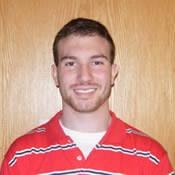
The shots were primarily for diagnostic development, but Rosenberg was able to utilize them for physics research. One of his most important findings is that the experimental yield from D3He exploding pushers is two orders of magnitude lower than predicted by average-ion radiation hydrodynamics codes. This dramatic drop in yield compared to simulation is largely due, not to traditional hydrodynamic mix to which such effects are often attributed (as in “conventional” ablator-driven implosions), but rather to kinetic and multi-ion effects. In this study, Rosenberg combined data from NIF and the OMEGA Laser Facility at the University of Rochester, and from both direct- and indirect-drive implosions. On the basis of this work, his thesis committee gave Rosenberg their highest commendation.
“Outstanding PhD research has continued to occur through the NIF PhD thesis program since its inception, as exemplified by Mike’s work, and Dan Casey’s before him,” said Rich Petrasso, head of the high energy density physics division at the MIT Plasma Science and Fusion Center.
Rosenberg was one of four MIT students—along with Hans Rinderknecht, Alex Zylstra, and Hong Sio—who played an important role in the March 12, 2013, NIF experiment in which a record DD fusion yield was achieved. They were part of the team responsible for fielding nuclear spectrometers that revealed critical internal plasma conditions of the implosion.
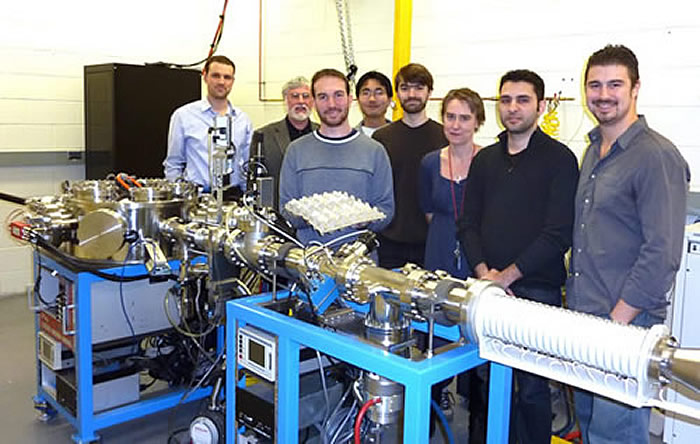 Members of the MIT-NIF team responsible for the development, testing, and calibration of the wedge range filter (WRF) proton spectrometers used on NIF. Mike Rosenberg holds a tray of the spectrometers next to the accelerator used in their final calibration.
Members of the MIT-NIF team responsible for the development, testing, and calibration of the wedge range filter (WRF) proton spectrometers used on NIF. Mike Rosenberg holds a tray of the spectrometers next to the accelerator used in their final calibration. 


